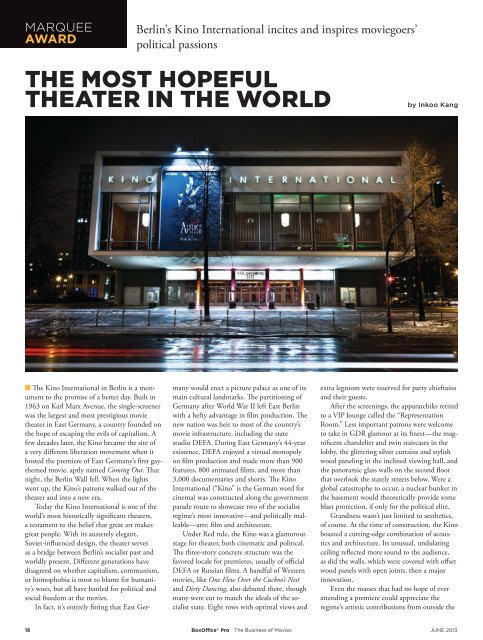You also want an ePaper? Increase the reach of your titles
YUMPU automatically turns print PDFs into web optimized ePapers that Google loves.
marquee<br />
award<br />
Berlin’s Kino International incites and inspires moviegoers’<br />
political passions<br />
The most hopeful<br />
theater in the world<br />
by Inkoo Kang<br />
n The Kino International in Berlin is a monument<br />
to the promise of a better day. Built in<br />
1963 on Karl Marx Avenue, the single-screener<br />
was the largest and most prestigious movie<br />
theater in East Germany, a country founded on<br />
the hope of escaping the evils of capitalism. A<br />
few decades later, the Kino became the site of<br />
a very different liberation movement when it<br />
hosted the premiere of East Germany’s first gaythemed<br />
movie, aptly named Coming Out. That<br />
night, the Berlin Wall fell. When the lights<br />
went up, the Kino’s patrons walked out of the<br />
theater and into a new era.<br />
Today the Kino International is one of the<br />
world’s most historically significant theaters,<br />
a testament to the belief that great art makes<br />
great people. With its austerely elegant,<br />
Soviet-influenced design, the theater serves<br />
as a bridge between Berlin’s socialist past and<br />
worldly present. Different generations have<br />
disagreed on whether capitalism, communism,<br />
or homophobia is most to blame for humanity’s<br />
woes, but all have battled for political and<br />
social freedom at the movies.<br />
In fact, it’s entirely fitting that East Germany<br />
would erect a picture palace as one of its<br />
main cultural landmarks. The partitioning of<br />
Germany after World War II left East Berlin<br />
with a hefty advantage in film production. The<br />
new nation was heir to most of the country’s<br />
movie infrastructure, including the state<br />
studio DEFA. During East Germany’s 44-year<br />
existence, DEFA enjoyed a virtual monopoly<br />
on film production and made more than 900<br />
features, 800 animated films, and more than<br />
3,000 documentaries and shorts. The Kino<br />
International (“Kino” is the German word for<br />
cinema) was constructed along the government<br />
parade route to showcase two of the socialist<br />
regime’s most innovative—and politically malleable—arts:<br />
film and architecture.<br />
Under Red rule, the Kino was a glamorous<br />
stage for theater, both cinematic and political.<br />
The three-story concrete structure was the<br />
favored locale for premieres, usually of official<br />
DEFA or Russian films. A handful of Western<br />
movies, like One Flew Over the Cuckoo’s Nest<br />
and Dirty Dancing, also debuted there, though<br />
many were cut to match the ideals of the socialist<br />
state. Eight rows with optimal views and<br />
extra legroom were reserved for party chieftains<br />
and their guests.<br />
After the screenings, the apparatchiks retired<br />
to a VIP lounge called the “Representation<br />
Room.” Less important patrons were welcome<br />
to take in GDR glamour at its finest—the magnificent<br />
chandelier and twin staircases in the<br />
lobby, the glittering silver curtains and stylish<br />
wood paneling in the inclined viewing hall, and<br />
the panoramic glass walls on the second floor<br />
that overlook the stately streets below. Were a<br />
global catastrophe to occur, a nuclear bunker in<br />
the basement would theoretically provide some<br />
blast protection, if only for the political elite.<br />
Grandness wasn’t just limited to aesthetics,<br />
of course. At the time of construction, the Kino<br />
boasted a cutting-edge combination of acoustics<br />
and architecture. Its unusual, undulating<br />
ceiling reflected more sound to the audience,<br />
as did the walls, which were covered with offset<br />
wood panels with open joints, then a major<br />
innovation.<br />
Even the masses that had no hope of ever<br />
attending a premiere could appreciate the<br />
regime’s artistic contributions from outside the<br />
C<br />
M<br />
Y<br />
CM<br />
MY<br />
CY<br />
CMY<br />
K<br />
18 BoxOffice ® <strong>Pro</strong> The Business of Movies june <strong>2013</strong>

















